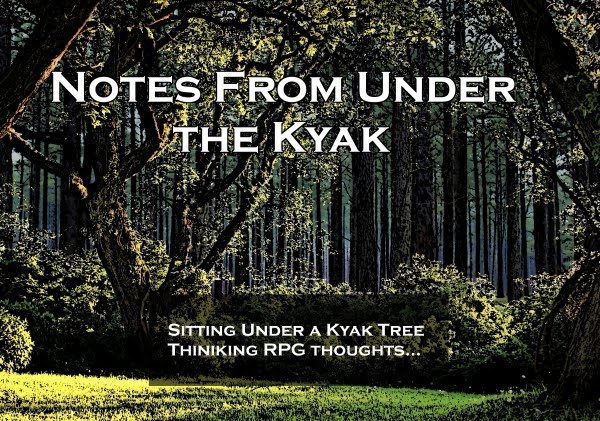Over on dragonsfoot.org someone suggested an alternative to the traditional 6 attributes (Strength, Dexterity, Constitution, Intelligence, Wisdom and Charisma) to 4 attributes, each split in two (Strength/Endurance, Dexterity/Agility, Intelligence/Perception, Will/Charisma).
Interesting notion. Somebody pointed the discussion to MEGS (Mayfair Exponential Game System)** which is cool: each attribute increase DOUBLES - hence the name - the ability so if a Strength 1 can lift 50 pounds, Strength 2 can lift 100 pounds, Strength 3 can lift 200 pounds, Strength 4 can lift 400 pounds, then 800, 1600, 3200, etc...
Neat idea and works for superheroes rather elegantly.
I'm more interested in their breakdown of abilities, however:
Dexterity, Strength, Body
Intelligence, Will, Mind
Influence, Aura, Spirit
What I like is the kind of holistic approach to body mind and spirit.
Here's a half-baked, untested, early morning attribute idea to consider:
Body: Strength, Dexterity, Constitution (or Strength, Agility, Health)
Mind: Intelligence, Wisdom or Perception, Sanity
Spirit: Influence or Leadership, Piety, Luck (Not completely sold on piety or luck, tbh)
Rolling Attributes: for each CATEGORY (Body, Mind, Spirit) roll 10d6 and arrange to taste (yes, you will have one bonus die to figure out what to do with). All must fall between 3 and 18.
OR
roll 3d6 for each attribute and roll one bonus die for each category, adding the whole die to one attribute. All must fall between 3 and 18.
OR
roll 3d6 (or 4d6 drop lowest) for each attribute in order or arrange to taste.
OR
maybe you roll differently for different archetypes with one (or maybe even TWO) bonus die in a single category: Mages might roll 3d6 straight for Body and Spirit but 3d6 plus one bonus die for mind. Clerics might get their bonus die in Spirit, Fighters in Body, Thieves could choose which one category they get a bonus die in (before they roll).
I'd use a universal bonus/penalty chart for the attributes because it's easier for me to remember, and I like patterns (again, easier to remember) so I'd use:
3 -3
4-5 -2
6-8 -1
9-12 +/-0
13-15 +1
16-17 +2
18 +3
(19-20 [+4]; 21-23 [+5]; 24-27 [+6]; 28-30 [+7]; etc. - not that I expect anyone to get that high, just more mental exercise)
WHY?
Now... there's no real reason to do this, I recognize that... unless mechanics are built out from here: you have broad categories and some granularity.
This could be useful for skills or ability checks or maybe saving throws.
Skills: a check against any of the sub-categories would be useful for general skill checks. Want to jump on the back of an untamed horse (or an elk or a rhino)? Give me a Dexterity check. So that's nothing new.
Saving Throws: The Category (Body, Mind, Spirit) checks would be against the AVERAGE of the scores in the category, round DOWN (say St 17, Dex 15, Con16 - BODY would be 16, whereas St 17, Dex 13, Con 10 BODY would be 13) or the bonus/penalty for Saves could be determined by the category (in the second example the person's strength would somewhat mitigate their lack of constitution and give them a BETTER bonus toward something like poison or paralysis, perhaps). System shock (jumping into freezing water, for example) would be a CATEGORY (Body) check, for good or ill...
But, again, there's no NEED for this. It's just a idea that I'm toying with.
I like the idea of all attributes being important in a game (I HATE the idea of a "dump stat") and the meaningful choices that come from making those decisions at the beginning of the game and then living with them (sometimes regretfully...). So I like systems where attributes/stats matter. Anyone can wear any armor they STRONG enough to wear (something like plate being reserved for ST 18, perhaps, while even leather armor might require a ST of at least 9). So the granularity comes into play in details like this.
** Yeah, crummy Wikipedia entry - but you get the gist of the system. One cool thing in the DC Heroes rules is that the rules are summarized in what they call "Eight Ideas": There are eight simple ideas behind the rules for the DC HEROES Role-Playing Game. In order to play the game, Players must be completely familiar with these eight ideas. (DC Heroes Third Edition page 82). I like the ability to summarize the system in X ideas or steps or whatever.



















,_from_The_Dance_of_Death_MET_DP-23040-001.jpg)


































_Road.jpg)
























%20by%20Christopher%20Shy.jpg)






































.png)
,_f.45v_-_BL_Yates_Thompson_MS_26.jpg)















.jpg)




































































































































.JPG)






















